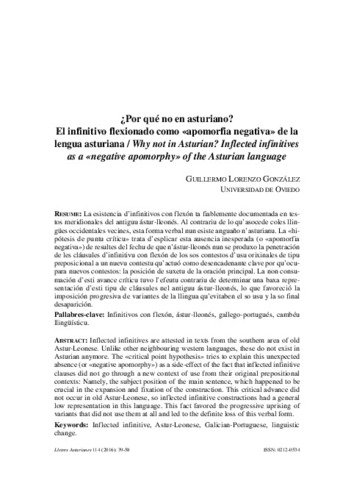¿Por qué no en asturiano? El infinitivo flexionado como «apomorfia negativa» de la lengua asturiana
Autor(es) y otros:
Palabra(s) clave:
Infinitivos con flexón
ástur-lleonés
gallego-portugués
cambéu llingüísticu
Inflected infinitive
Astur-Leonese
Galician-Portuguese
linguistic change
Fecha de publicación:
Editorial:
Academia de la Llingua Asturiana
Citación:
Descripción física:
Resumen:
La esistencia d’infinitivos con flexón ta fiablemente documentada en testos meridionales del antiguu ástur-lleonés. Al contrariu de lo qu’asocede coles llingües occidentales vecines, esta forma verbal nun esiste anguaño n’asturianu. La «hipótesis de puntu críticu» trata d’esplicar esta ausencia inesperada (o «apomorfia negativa») de resultes del fechu de que n’ástur-lleonés nun se produxo la penetración de les cláusules d’infinitivu con flexón de los sos contestos d’usu orixinales de tipu preposicional a un nuevu contestu qu’actuó como desencadenante clave por qu’ocupara nuevos contestos: la posición de suxetu de la oración principal. La non consumación d’esti avance críticu tuvo l’efeutu contrariu de determinar una baxa representación d’esti tipu de cláusules nel antiguu ástur-lleonés, lo que favoreció la imposición progresiva de variantes de la llingua qu’evitaben el so usu y la so final desaparición.--Inflected infinitives are attested in texts from the southern area of old Astur-Leonese. Unlike other neighbouring western languages, these do not exist in Asturian anymore. The «critical point hypothesis» tries to explain this unexpected absence (or «negative apomorphy») as a side-effect of the fact that inflected infinitive clauses did not go through a new context of use from their original prepositional contexts: Namely, the subject position of the main sentence, which happened to be crucial in the expansion and fixation of the construction. This critical advance did not occur in old Astur-Leonese, so inflected infinitive constructions had a general low representation in this language. This fact favored the progressive uprising of variants that did not use them at all and led to the definite loss of this verbal form
La esistencia d’infinitivos con flexón ta fiablemente documentada en testos meridionales del antiguu ástur-lleonés. Al contrariu de lo qu’asocede coles llingües occidentales vecines, esta forma verbal nun esiste anguaño n’asturianu. La «hipótesis de puntu críticu» trata d’esplicar esta ausencia inesperada (o «apomorfia negativa») de resultes del fechu de que n’ástur-lleonés nun se produxo la penetración de les cláusules d’infinitivu con flexón de los sos contestos d’usu orixinales de tipu preposicional a un nuevu contestu qu’actuó como desencadenante clave por qu’ocupara nuevos contestos: la posición de suxetu de la oración principal. La non consumación d’esti avance críticu tuvo l’efeutu contrariu de determinar una baxa representación d’esti tipu de cláusules nel antiguu ástur-lleonés, lo que favoreció la imposición progresiva de variantes de la llingua qu’evitaben el so usu y la so final desaparición.--Inflected infinitives are attested in texts from the southern area of old Astur-Leonese. Unlike other neighbouring western languages, these do not exist in Asturian anymore. The «critical point hypothesis» tries to explain this unexpected absence (or «negative apomorphy») as a side-effect of the fact that inflected infinitive clauses did not go through a new context of use from their original prepositional contexts: Namely, the subject position of the main sentence, which happened to be crucial in the expansion and fixation of the construction. This critical advance did not occur in old Astur-Leonese, so inflected infinitive constructions had a general low representation in this language. This fact favored the progressive uprising of variants that did not use them at all and led to the definite loss of this verbal form
Colecciones
- Artículos [37533]
- Filología Española [536]
Ficheros en el ítem




